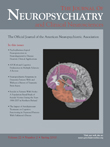Manic Episode Following a Combined Treatment of Repetitive Transcranial Magnetic Stimulation and Venlafaxine
To the Editor: Repetitive transcranial magnetic stimulation (rTMS) is a new treatment for depression. Numerous sham-controlled trials support its efficacy in treating depression. 1 There were a few reports of side-effects in patients receiving rTMS. 2 Headache was the most often reported; epilepsy and mania were less frequent. Here we report a new-onset manic episode in a patient following a concomitant treatment of rTMS and venlafaxine.
Case Report
Mr. C is a 45-year-old Chinese man who was brought to our psychiatric clinic due to depression, poor sleep, psychomotor retardation, and suicidal ideas. His symptoms started 1 year ago following occupational problems. He had no history of bipolar disorder. His family history revealed no known bipolar disorder. He visited several psychiatric clinics before coming to our outpatient clinic. Many antidepressants, including selective serotonin reuptake inhibitors (SSRIs) and serotonin and norepinephrine reuptake inhibitors (SNRIs), were prescribed, but he continued to experience depressed mood and suicidal ideation. We admitted him to our acute ward, and he was given venlafaxine, 75 mg/day, in the first week and then 150 mg/day thereafter.
He scored 41 points on evaluation with the Beck Depression Inventory (BDI-II), 28 points on the Hamilton Depression Rating Scale (HAM-D), and 0 points on the Young Mania Rating Scale (YMRS). Because his depression persisted, rTMS was added to his treatment, once daily for 10 sessions in 2 weeks. We used a Magstim ultra rapid device, with a figure-eight coil, over the left prefrontal-cortex. We used 90% motor threshold, 20Hz frequency, 2-second duration each train, and 20 trains each session.
After 1 week of treatment, the patient’s depression improved significantly (BDI-II score = 16, HAM-D score = 11, YMRS score = 2). After 2 weeks, his BDI-II score improved to 13, his HAM-D score improved to 13, and his YMRS improved to 4, so he was discharged.
One month after discharge, he had hyperactivities, hypertalkativeness, buying sprees, and decreased need for sleep with high energy. He was brought to our clinic by his family and was hospitalized. We discontinued venlafaxine, and valproic acid, 1,200 mg/day, and olanzapine, 10 mg/day, were used to treat mania. His symptoms improved gradually.
Mr. C became depressed progressively in weeks. Valproic acid was discontinued, and olanzapine was decreased to 5 mg/day. He has been well and followed up regularly after fluvoxamine, 50 mg/day, was prescribed.
Discussion
This case indicates that a concomitant treatment of rTMS and venlafaxine might induce mania. A literature review showed that the age of bipolar I disorders onset is generally between 15 and 30 years old. Manic episodes predominate in young patients. 3 However, this patient was not so typical because of first manic episode at 45 years old without family history. This unusual course suggests that rTMS or venlafaxine may provoke mania.
Could this effect be attributed to venlafaxine only? Venlafaxine-associated mania has been previously reported. 4 , 5 One study revealed that a 44-year-old woman with major depression reached a maximum of 237.5 mg/day of venlafaxine, in the third month of treatment, and another patient with bipolar history developed mania. However, venlafaxine, 150 mg/day, was prescribed for our patient without bipolar history. Previously, our patient received SSRIs and SNRIs in adequate doses without mania. Therefore, we suggest that a concomitant treatment of rTMS and venlafaxine may induce mania.
1. Gross M, Nakamura L, Pascual-Leone A, et al: Has repetitive transcranial magnetic stimulation (rTMS) treatment for depression improved? A systematic review and meta-analysis comparing the recent vs. the earlier rTMS studies. Acta Psychiatr Scand 2007; 116:165–173Google Scholar
2. Loo CK, McFarquhar TF, Mitchell PB: A review of the safety of repetitive transcranial magnetic stimulation as a clinical treatment for depression. Int J Neuropsychopharmacol 2008; 11:131–147Google Scholar
3. Emilien G, Septien L, Brisard C, et al: Bipolar disorder: how far are we from a rigorous definition and effective management? Prog Neuropsychopharmacol Biol Psychiatry 2007; 31:975–996Google Scholar
4. Stoner SC, Williams RJ, Worrel J, et al: Possible venlafaxine-induced mania. J Clin Psychopharmacol 1999; 19:184–185Google Scholar
5. Shulman RB, Scheftner WA, Nayudu S: Venlafaxine-associated mania. J Clin Psychopharmacol 2001; 21:239–241Google Scholar



